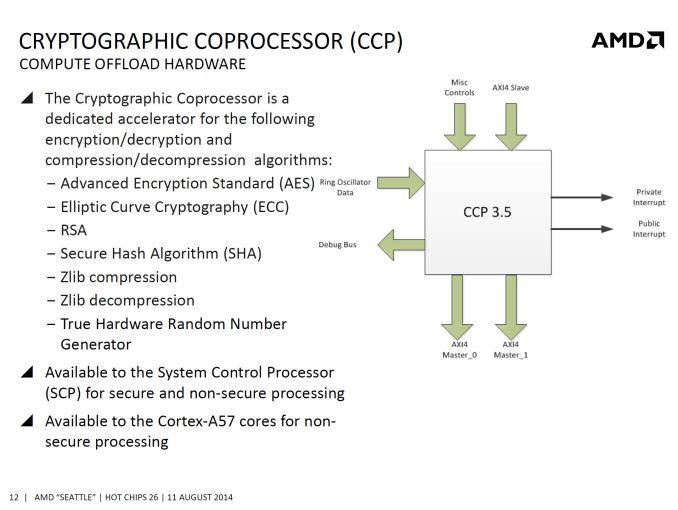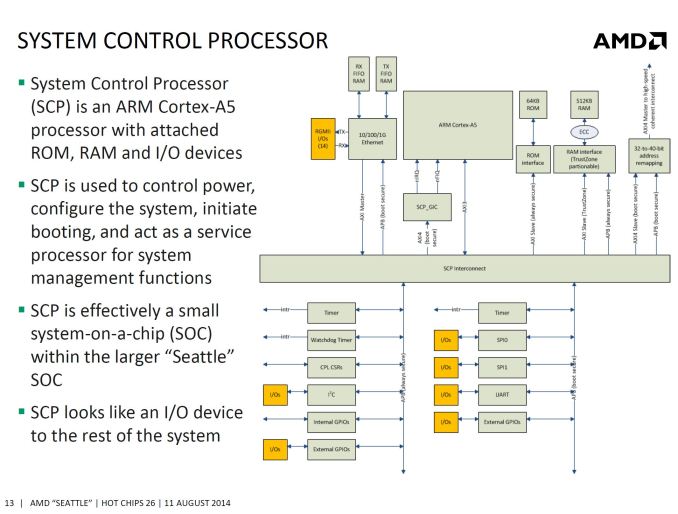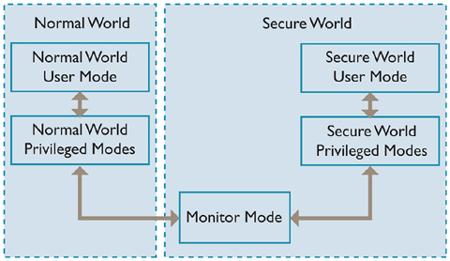AMD’s Big Bet on ARM Powered Servers: Opteron A1100 Revealed
by Stephen Barrett on August 11, 2014 12:00 PM EST- Posted in
- SoCs
- IT Computing
- AMD
- Arm
- Opteron
- server
- Enterprise CPUs
- Opteron A1100
AMD’s Special Sauce: A1100’s Co-Processors
This year, AMD has answered some critics of their business by describing their plans to regain a differentiated position on the market. One of the key slides AMD used to described its position showed ARM, GPU, and x86 cores at the center surrounded by complementary IP.
AMD’s argument is it is uniquely positioned as the only chip company with powerful graphics, ARM and x86 CPU designs, a server heritage including security and fabric (thanks SeaMicro), as well as extensive chip packaging, motherboard and server design expertise.
The complementary IP AMD brings to the A1100 is two Co-Processors. The Cryptographic CoProcessor (CCP) and the System Control Processor (SCP).
While the Cortex A57s include cryptographic instructions courtesy of the ARMv8 ISA, there are times when a server has significant cryptographic load and it is better to offload that to a coprocessor than service it directly on the CPU core. Cryptographic transactions such as https are well suited for the CPU core as they require low latency and the overhead to offload the work often negates the acceleration the coprocessor provides. However, cryptographic transactions such as archive compression/decompression and large data set encryption/decryption can benefit tremendously.
Utilizing the coprocessor requires operating system awareness to redirect cryptography functions to the dedicated hardware instead of doing them with the general purpose hardware. For example, requesting a random number from the OS would ideally fetch it from the CCP. AMD has already committed an update to the Linux 3.14 kernel to support this.
The SCP is based around an ARM Cortex-A5 processor and is effectively an SoC itself inside the A1100 SoC. The rest of the A1100 communicates to the SCP as if it is an IO device. This seems weird, but the isolation is by design. There are two reasons for this: Out-of-band management, and secure processing with ARM TrustZone technology.
Out-of-band management is a technique used in industry for servicing and diagnosing deployed systems regardless of the state of its normal operation or ‘in-band’ components. The SCP has its own dedicated 10/100/100 Ethernet connection, RAM, ROM, and IO connectivity. Connecting from a management interface, a user can read and configure motherboard devices like temperature sensors, power supplies, and fans completely independent from the rest of the A1100 SoC’s activities. Since the SCP is also core to the boot process, server administrators can also reset servers remotely.
One of the other reasons the SCP exists it to implement ARM's TrustZone technology. AMD announced two years ago they would be partnering with ARM to implement TrustZone technology into future CPUs, and this is the first server CPU to receive the feature. This processor is actually already present in AMD’s x86s APUs. To recap, TrustZone is an ARM technology providing a ‘secure world’ inside the SoC. Programming routines requiring utmost security, like digital rights management, can execute inside the SCP and are protected from unauthorized access from the ‘normal world’. These features are typically found in consumer devices, as certain applications like Netflix require a secure processing path to play HD content. AMD likely reused their TrustZone processor design from consumer APUs to implement the SCP, and it will be interesting to see how server software takes advantage of it.
















28 Comments
View All Comments
Stuka87 - Monday, August 11, 2014 - link
Unless I missed it, what process are these being made on? I would hope they are one of the 20nm processes, but maybe they are still 28nm?VulgarDisplay - Monday, August 11, 2014 - link
The article said 28nm.richricard - Monday, August 11, 2014 - link
Where...?VeauX - Monday, August 11, 2014 - link
Last page, on the AMD slides bellow the "what is it" sectiondgingeri - Monday, August 11, 2014 - link
This could be a great thing. As a systems admin, I can see the need for small, low power servers for local purposes.They'd be great for branch offices or small offices who have much of their infrastructure in the cloud or remote datacenters. Imagine spending $1000 on a local domain controller and file server branch cache with everything else remote instead of having to spend the $5000 we do today.
They'd also be great for a local departmental authentication server in a large office. Keep one as a domain controller in the wiring closet with the local switches for each physical section of the office, and it would reduce the load on the main domain controller in the datacenter, reducing equipment requirements, power consumption, and cooling costs. It would also increase redundancy of the AD domain.
There are a lot of possibilities for this thing. Virtualization has already taken care of most of the uses it could have had, but lower power servers do offer an alternative to that, too.
thesnowman - Tuesday, August 12, 2014 - link
Unless you are going to use Linux and run samba for active directory and file server duties this CPU is not suitable. Windows Server does not run on ARM (yet).iAPX - Tuesday, August 12, 2014 - link
The reference design is clearly tardeted at NAS, powerful NAS up to 8 drives, on the SOHO space. But I see an effective way to use it as Memcache server (without storage), benefitting of it's 128GB memory space with a power-effective CPU, probably 2 of them in a 1U box.There's also other possibilities, such as SSD + 8core ARM CPU, 2 of them on a 1U box, for MongoDB or CouchDB.
Beside this reference design, there's a world of possibilities, considering this SoC and it's incredible potential (when it's not CPU-hungry tasks!)
LarsBars - Monday, August 11, 2014 - link
Has Microsoft ever dropped hints about future versions of Windows Server supporting ARM? Obviously they've done Windows on ARM before (Windows RT) but I've never heard any mention of Windows Server running on these new AMD ARM CPUs.LarsBars - Monday, August 11, 2014 - link
Okay, I probably should have looked it up first: http://www.pcworld.com/article/2092620/microsoft-j...I'm guessing a big blocker to Windows Server on ARM would be getting people to convert server workloads to run on ARM that currently run on x64. But I could actually see one potential usage for Windows Server ARM: storage spaces. If Windows Server 2012 R2 (or vNext) gets developed for ARM, we could see ARM-based Windows Server storage devices serving up SAN-competitive iSCSI and SMB storage, at a greatly reduced cost.
someone0 - Monday, August 11, 2014 - link
Maybe, it's all depend on what the market wants. If people want enough servers on ARM, there will eventually be Windows server for ARM. and may even be based on RT. If you remember Windows for IA-64, that will tell you how much MS willing to bang its server OS off the x86 codes. If not linux will steal all the markets. OS for server is a different beast, most servers don't need to run the usual x86 and usual win32/64 based applications.